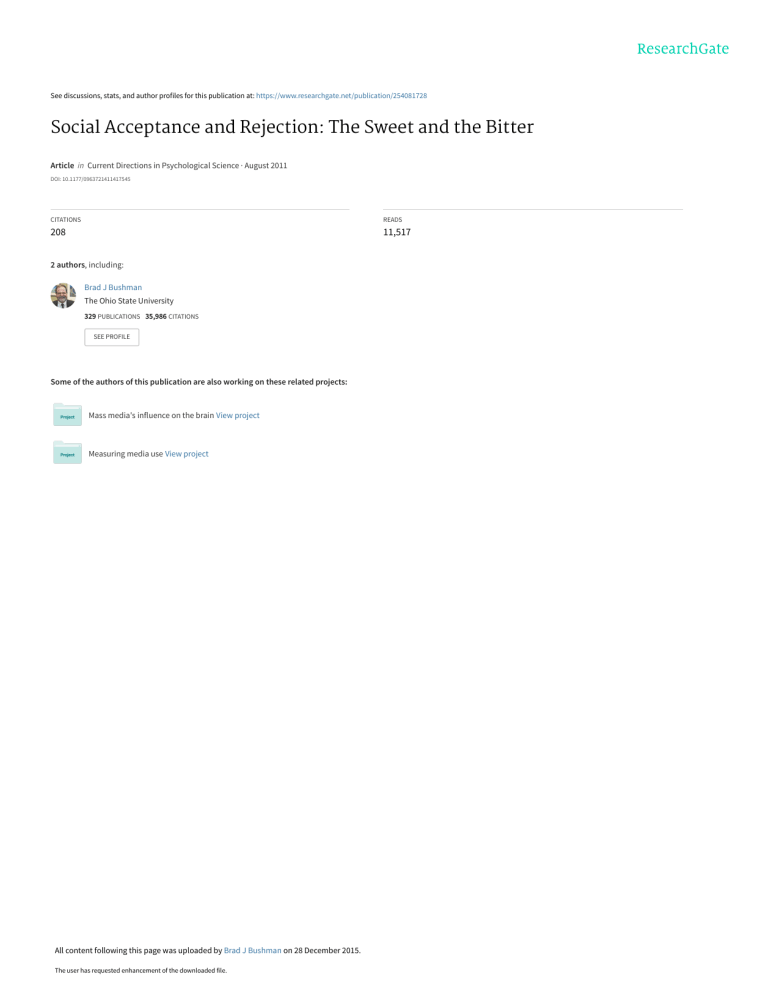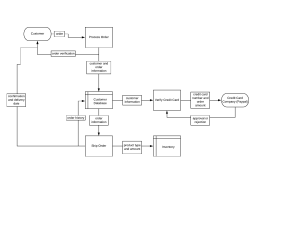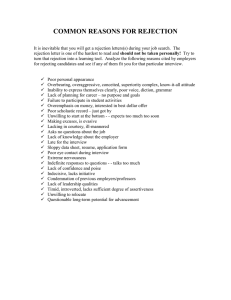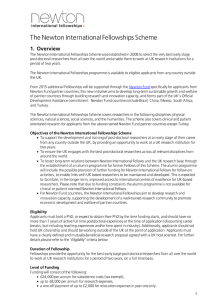
See discussions, stats, and author profiles for this publication at: https://www.researchgate.net/publication/254081728 Social Acceptance and Rejection: The Sweet and the Bitter Article in Current Directions in Psychological Science · August 2011 DOI: 10.1177/0963721411417545 CITATIONS READS 208 11,517 2 authors, including: Brad J Bushman The Ohio State University 329 PUBLICATIONS 35,986 CITATIONS SEE PROFILE Some of the authors of this publication are also working on these related projects: Mass media's influence on the brain View project Measuring media use View project All content following this page was uploaded by Brad J Bushman on 28 December 2015. The user has requested enhancement of the downloaded file. Social Acceptance and Rejection: The Sweet and the Bitter Current Directions in Psychological Science 20(4) 256­–260 © The Author(s) 2011 Reprints and permission: sagepub.com/journalsPermissions.nav DOI: 10.1177/0963721411417545 http://cdps.sagepub.com C. Nathan DeWall1 and Brad J. Bushman2 1 University of Kentucky and 2The Ohio State University and VU University, Amsterdam Abstract People have a fundamental need for positive and lasting relationships. In this article, we provide an overview of social psychological research on the topic of social acceptance and rejection. After defining these terms, we describe the need to belong and how it enabled early humans to fulfill their survival and reproductive goals. Next, we review research on the effects of social rejection on emotional, cognitive, behavioral, and biological responses. We also describe research on the neural correlates of social rejection. We offer a theoretical account to explain when and why social rejection produces desirable and undesirable outcomes. We then review evidence regarding how people cope with the pain of social rejection. We conclude by identifying factors associated with heightened and diminished responses to social rejection. Keywords social rejection, social exclusion, social acceptance, need to belong Deep down even the most hardened criminal is starving for the same thing that motivates the innocent baby: Love and acceptance. — Lily Fairchilde Hardened criminals may seem worlds apart from innocent babies. Yet, as the Fairchilde quote suggests, there is reason to believe that most people share a similar craving for social acceptance. Social acceptance is pleasant, rewarding, and, in moderate amounts, associated with various indicators of wellbeing. Over the past 15 years, there has been tremendous interest within the social psychological literature on the flipside of social acceptance—namely, social rejection. Social rejection thwarts the fundamental need for positive and lasting relationships, which strikes at the core of well-being. Thus, the human need for social connection can be both a sweet blessing when others accept us and a bitter curse when others reject us. In this article, we provide an overview of social psychological research on the topic of social acceptance and rejection. The article is divided into five sections. First, we provide conceptual and operational definitions of social acceptance and social rejection. Second, we describe the need to belong and how it enabled early humans to fulfill their survival and reproductive goals. Third, we review research on the effects of social rejection on emotional, cognitive, behavioral, and biological responses. We also review research on the neural correlates of social rejection. Fourth, we review evidence on how people cope with the pain of social exclusion. Fifth, we identify factors associated with heightened and diminished responses to social rejection. What Are Social Acceptance and Social Rejection? Social acceptance means that other people signal that they wish to include you in their groups and relationships (Leary, 2010). Social acceptance occurs on a continuum that ranges from merely tolerating another person’s presence to actively pursuing someone as a relationship partner. Social rejection means that others have little desire to include you in their groups and relationships (Leary, 2010). Social rejection also is a complex construct, consisting of behaviors that can range from ignoring another person’s presence to actively expelling him or her from a group or existing relationship. People can experience acceptance and rejection chronically or acutely. People experience social acceptance and rejection in numerous ways. Examples of acceptance include being chosen for a desirable job or having a romantic partner say “yes” to a marriage proposal. Examples of rejection include divorce or being ignored by one’s coworkers. Psychologists have devised several innovative manipulations of social acceptance and Corresponding Author: C. Nathan DeWall, 201 Kastle Hall, Department of Psychology, University of Kentucky, Lexington, KY 40506-0044 E-mail: nathan.dewall@uky.edu Social Acceptance and Rejection rejection, including leading participants to believe that everyone or no one chose them to be in their group (Maner, DeWall, Baumeister, & Schaller, 2007) or having confederates (real or virtual) include or exclude them in a ball-tossing game (Williams, Cheung, & Choi, 2000). Why Is Social Acceptance Sweet and Social Rejection Bitter? The need to belong is defined as the desire to form and maintain close, lasting relationships with some other individuals (Baumeister & Leary, 1995). The need to belong has two parts. First, people want some kind of positive regular social contact. Second, people want the stable framework of some ongoing relationship in which the the individuals share a mutual concern for each other. Having either of these without the other provides only partial satisfaction of the need to belong. Being motivated to have positive and lasting relationships conferred a tremendous advantage among our evolutionary ancestors. With no fangs, fur, or claws, and with long, vulnerable childhoods, humans are ill-suited to fulfill their survival and reproductive needs living in isolation. Given these vulnerabilities, early humans survived harsh environments by depending on small groups of other individuals to meet many of their survival and reproductive needs. The benefits of acceptance and group living extend beyond protection from predators and providing mates to spread one’s genes to future generations. Cooperative group living enabled early humans to share and receive resources from each other, thereby making it unnecessary for individuals to carry the entire burden of their well-being on their own shoulders. Therefore, social rejection is experienced as “bitter” in order to motivate individuals to avoid a negative state in which they do not receive the benefits of inclusion, which ultimately decreases their survival rate. Because our ancestors evolved in small groups, social rejection likely signified a death sentence. Even among early civilizations, such as that of the Greeks, exile and death were treated as equivalent punishments. In contrast, social acceptance is experienced as “sweet” in order to reinforce a positive state in which people enjoy the rewards associated with inclusion. How Do People Respond to Social Rejection? Because social rejection thwarts a core human need, it is not surprising that it influences a variety of outcomes—emotional, cognitive, behavioral, biological, and neural. In terms of emotional responses, social rejection tends to increase various types of negative emotion. Hurt feelings are the core emotional marker of social rejection, but rejection also increases anxiety, anger, sadness, depression, and jealousy (Leary, 2010). Social rejection also diminishes state self-esteem, defined as temporary feelings of self-worth (Williams et al., 2000). 257 Social rejection influences cognitive processes in two main ways. First, it reduces performance on challenging intellectual tasks, resulting in subpar performance (e.g., Baumeister, Twenge, & Nuss, 2002). Second, social rejection causes people to become cognitively attuned to potential sources of social acceptance and to potential threats, presumably as a means of gaining acceptance from others (e.g., Williams et al., 2000). Rejected people can also be hypersensitive to signs of threat. For example, rejected people perceive hostility when confronted with ambiguously aggressive actions of a stranger who does not represent a source of affiliation (DeWall, Twenge, Gitter, & Baumeister, 2009). Social rejection affects a broad assortment of behaviors. Although it undermines the chances of gaining acceptance, social rejection often increases aggression. In the laboratory, rejected people, compared to nonrejected people, blast strangers with intense and prolonged white noise, dole out large amounts of hot sauce to people who hate spicy food, and give destructive evaluations of potential job candidates (e.g., Twenge, Baumeister, Tice, & Stucke, 2001). Outside of the laboratory, social rejection is implicated in acts of mass violence. For example, an analysis of 15 school shooters found that social rejection was present in all but 2 of the cases (Leary, Kowalski, Smith, & Phillips, 2003). Some recent evidence demonstrates that a hostile cognitive bias mediates the relationship between threats of social rejection and aggression (DeWall et al., 2009). Crucially, offering socially rejected people a small taste of acceptance, even from one stranger, is enough to reduce their aggression (DeWall, Twenge, Bushman, Im, & Williams, 2010). Similar effects emerge with prosocial behavior. Socially rejected people generally behave selfishly, but they engage in prosocial behavior when doing so can earn them acceptance (Maner et al., 2007). Thus, antisocial and prosocial responses to social rejection hinge partly on the prospect of social acceptance. Social rejection also undermines self-regulation—better known as impulse control. When given the opportunity, socially rejected people will eat over twice as many good-tasting but unhealthy cookies as nonrejected people will, but they will consume only one third as much of a bad-tasting but healthy beverage (Baumeister, DeWall, Ciarocco, & Twenge, 2005). When socially rejected people receive an incentive for effective selfregulation, such as money, they regain their motivation and perform well. Framing self-regulation performance as a means of gaining future acceptance is also effective in undoing the self-regulation deficits following social rejection (DeWall, Baumeister, & Vohs, 2008). These findings again highlight the importance of promises of acceptance in motivating socially rejected people to engage in desirable behavior. Social rejection influences a variety of biological responses. When people experience social rejection, their hearts literally slow down (Gunther Moor, Crone, & van der Molen, 2010) and they experience motivationally tuned changes in progesterone, a hormone associated with social-affiliative motivation 258 (Maner, Miller, Schmidt, & Eckel, 2010). Social rejection and other forms of social-evaluative threat, defined as a context in which a person can be judged negatively by others, increases the release of the stress hormone cortisol (Dickerson & Kemeny, 2004) and stimulates production of proinflammatory cytokines (Dickerson, Gable, Irwin, Aziz, & Kemeny, 2009). In terms of neural correlates, social rejection increases activation in brain regions (e.g., dorsal anterior cingulate cortex, anterior insula) that are associated with the affective component of physical pain (i.e., the “unpleasantness” aspect of pain, as opposed to the sensory component on knowing that one is experiencing pain; Eisenberger, Lieberman, & Williams, 2003). Coping With Social Rejection If social rejection produces such varied (and often negative) outcomes, it is incumbent upon psychological scientists to identify how people can cope with the pain it causes. To be sure, many of the previously mentioned responses to social rejection may represent coping responses. Rejected people may behave aggressively, for example, because they believe doing so may make them feel better. In addition, striving to identify and form bonds with new friends represents another way that people cope with the pain of rejection. Recent research suggests that social rejection sets in motion an automatic emotion regulation process in which positive emotions become highly accessible (DeWall et al., in press). Socially rejected participants, compared to nonrejected participants, recalled more positive childhood memories, completed more word stems with positive emotion words, and made biased judgments to include more positive emotion in their perception of word similarity. These findings offer initial evidence that social rejection produces strong positive emotional responses at an implicit level, possibly as a means of warding off later distress. People also cope with social rejection by turning to religion (Aydin, Fischer, & Frey, 2010). Compared to nonrejected people, socially rejected people express greater religious affiliation and greater intentions to engage in religious activities. Priming rejected people with religious thoughts reduces their aggression. Crucially, coping with social rejection through the use of religion was found among both Christians and Muslims. Apparently the use of religion as a means of coping with social rejection does not depend on the teachings of a particular religion. Because there is some shared overlap in neural regions associated with physical pain and social rejection, numbing people to physical pain may also diminish the pain of social rejection. In a test of this hypothesis, participants took a daily dose of acetaminophen (the active ingredient in Tylenol) or a placebo and reported their daily hurt feelings (DeWall, MacDonald, et al., 2010). As predicted, the pain reliever reduced daily hurt feelings compared to the placebo. A follow-up study showed that compared to placebo, acetaminophen reduced neural activation to a social rejection manipulation in the DeWall, Bushman dorsal anterior cingulate cortex (dACC) and anterior insula (see Fig. 1). Thus, an over-the-counter analgesic commonly used to treat physical pain was effective in reducing emotional responses and neural correlates of social rejection. Individual Factors Associated With Heightened and Diminished Responses to Social Rejection Social rejection means different things to different people. Although social rejection poses a basic threat to most people, enduring patterns of inner experience and behavior are associated with heightened or diminished responses. For example, behavioral and emotional responses to social rejection are particularly pronounced among people high in rejection sensitivity (Ayduk, Gyurak, & Luerssen, 2008) and high in anxious attachment (Vorauer, Cameron, Holmes, & Pearce, 2003). Neural correlates of rejection and social disapproval are strongest among people high in rejection sensitivity (Burklund, Eisenberger, & Lieberman, 2007) and low in selfesteem (Onoda et al., 2010). Although rejection-sensitive people behave quite aggressively when there is no possibility of gaining acceptance, they can also show hormonal and behavioral responses reflecting a strong desire for affiliation. After experiencing social rejection, highly rejection-sensitive people experience increases in their progesterone levels and go out of their way to make a good impression on potential affiliates (e.g., Maner et al., 2010). In contrast, socially anxious people respond to social rejection with hormonal and behavioral responses indicative of a weak desire for affiliation (Maner et al., 2007, 2010). To our knowledge, only one study thus far has identified an individual risk factor associated with relative immunity to social rejection (Wirth, Lynam, & Williams, 2010). In that study, socially rejected participants who scored highly on a configuration of traits descriptive of Cluster A personality disorders (paranoid, schizoid, schizotypal) experienced less reductions in their feelings of belonging, self-esteem, control, meaningful existence, and positive affect relative to participants who scored low on these traits. Future work may explore other individual factors associated with relative immunity to social rejection. Conclusion Fifteen years ago, there was almost no social psychological research investigating how social acceptance and rejection affect people. As shown in this review, an explosion of theorizing and research has filled this void. This work has clarified how social rejection influences a broad range of outcomes— emotional, cognitive, behavioral, biological, and neural. It has shed light on how desirable and undesirable responses to social rejection often hinge on the prospect of acceptance or some other enticing benefit. It has examined ways that people 259 Social Acceptance and Rejection a b 5 4 3 2 1 dACC (9, 27, 21) t=0 Anterior Insula (45, 21, –9) Placebo Acetaminophen 0.4 0.2 0 –0.2 –0.4 –0.6 2.0 Activity During Exclusion vs. Inclusion Activity During Exclusion vs. Inclusion 0.6 Placebo Acetaminophen 1.6 1.2 0.8 0.4 0 –0.4 –0.8 Fig. 1. Activation in regions associated with the pain of social rejection—the dorsal anterior cingulate cortex (dACC; a) and anterior insula (b)—in response to social exclusion (vs. inclusion) in those receiving acetaminophen and those receiving a placebo. The illustration above each graph shows change in intensity of neural activity that was greater for participants who took placebo than for those who took acetaminophen (see the color bar); results are averaged across both conditions. The circled regions are those for which results are given in the bar graphs. Source: DeWall, C.N., MacDonald, G.,Webster, G.D., Masten, C., Baumeister, R.F., Powell, C., et al. (2010). Acetaminophen reduces social pain: Behavioral and neural evidence. Psychological Science, 21, 931–937. cope with social rejection and how medications designed to diminish physical pain can also diminish the pain of rejection. And it has identified individual factors that predispose people to react harshly or weakly to social rejection. As this research literature enters its second generation, it is critical for researchers to consider the impact of social acceptance and rejection within the context of ongoing relationships. Thus far, researchers have focused almost entirely on social acceptance and rejection experienced from strangers, leaving open the question of whether these results relate to existing relationships. Examining the time course of responses to social acceptance and rejection is also significant, as most research thus far offers a snapshot of immediate responses and does not investigate how responses strengthen or decay over time. Thus, the social acceptance and rejection literature offers fertile ground for psychological scientists to unlock the mysteries underlying the need to belong—and how satisfying or thwarting this need gives insight into human nature. Recommended Reading Baumeister, R.F., & Leary, M.R. (1995). (See References). A key theoretical piece on how people have a fundamental need to belong. DeWall, C.N., MacDonald, G., Webster, G.D., Masten, C., Baumeister, R.F., Powell, C., et al. (2010). (See References). Provides the first evidence that acetaminophen, a physical pain killer, can reduce the pain of social rejection. Leary, M.R. (2010). (See References). A comprehensive review for readers wishing to expand their knowledge on the field of social acceptance and rejection. Williams, K.D., Cheung, C.K.T., & Choi, W. (2000). (See References). Introduction and validation of the most widely used manipulation of social rejection: Cyberball. Declaration of Conflicting Interests The author(s) declared no potential conflicts of interest with respect to the research, authorship, and/or publication of this article. 260 References Aydin, N., Fischer, P., & Frey, D. (2010). Turning to God in the face of ostracism: Effects of social exclusion on religiousness. Personality and Social Psychology Bulletin, 36, 742–753. Ayduk, O., Gyurak, A., & Luerssen, A. (2008). Individual differences in the rejection–aggression link in the hot sauce paradigm: The case of rejection sensitivity. Journal of Experimental Social Psychology, 44, 775–782. Baumeister, R.F., DeWall, C.N., Ciaracco, N.J., & Twenge, J.M. (2005). Social exclusion impairs self–regulation. Journal of Personality and Social Psychology, 88, 589–604. Baumeister, R.F., & Leary, M.R. (1995). The need to belong: Desire for interpersonal attachments as a fundamental human motivation. Psychological Bulletin, 117, 497–529. Baumeister, R.F., Twenge, J.M., & Nuss, C.K. (2002). Effects of social exclusion on cognitive processes: Anticipated aloneness reduces intelligent thought. Journal of Personality and Social Psychology, 83, 817–827. Burklund, L.J., Eisenberger, N.I., & Lieberman, M.D. (2007). The face of rejection: Rejection sensitivity moderates dorsal anterior cingulate activity to disapproving facial expressions. Social Neuroscience, 2, 238–253. DeWall, C.N., Baumeister, R.F., & Vohs, K.D. (2008). Satiated with belongingness?: Effects of acceptance, rejection, and task framing on self–regulatory performance. Journal of Personality and Social Psychology, 95, 1367–1382. DeWall, C.N., MacDonald, G., Webster, G.D., Masten, C., Baumeister, R.F., Powell, C., et al. (2010). Acetaminophen reduces social pain: Behavioral and neural evidence. Psychological Science, 21, 931–937. DeWall, C.N., Twenge, J.M., Bushman, B.J., Im, C., & Williams, K.D. (2010). Acceptance by one differs from acceptance by none: Applying social impact theory to the rejection–aggression link. Social Psychological and Personality Science, 1, 168–174. DeWall, C.N., Twenge, J.M., Gitter, S.A., & Baumeister, R.F. (2009). It’s the thought that counts: The role of hostile cognitions in shaping aggression following rejection. Journal of Personality and Social Psychology, 96, 45–59. DeWall, C.N., Twenge, J.M., Koole, S.L., Baumeister, R.F., Marquez, A., & Reid, M.W. (in press). Automatic emotion regulation after social exclusion: Tuning to positivity. Emotion. Dickerson, S.S., Gable, S.L., Irwin, M.R., Aziz, N., & Kemeny, M.E. (2009). Social-evaluative threat and proinflammatory cytokine View publication stats DeWall, Bushman regulation: An experimental laboratory investigation. Psychological Science, 20, 1237–1244. Dickerson, S.S., & Kemeny, M.E. (2004). Acute stressors and cortisol responses: A theoretical integration and synthesis of laboratory research. Psychological Bulletin, 130, 355–391. Eisenberger, N.I., Lieberman, M.D., & Williams, K.D. (2003). Does rejection hurt? An fMRI study of social exclusion. Science, 302, 290–292. Gunther Moor, B., Crone, E.A., & van der Molen, M.W. (2010). The heartbrake of social rejection: Heart rate deceleration in response to unexpected peer rejection. Psychological Science, 21, 1326–1333. Leary, M.R. (2010). Affiliation, acceptance, and belonging. In S.T. Fiske, D.T. Gilbert & G. Lindzey (Eds.), Handbook of Social Psychology (5th Ed., Vol. 2, pp. 864–897). New York, NY: Wiley. Leary, M.R., Kowalski, R.M., Smith, L., & Phillips, S. (2003). Teasing, rejection, and violence: Case studies of the school shootings. Aggressive Behavior, 29, 202–214. Maner, J.K., DeWall, C.N., Baumeister, R.F., & Schaller, M. (2007). Does social exclusion motivate withdrawal or reconnection? Resolving the “porcupine problem.” Journal of Personality and Social Psychology, 92, 42–55. Maner, J.K., Miller, S.L., Schmidt, N.B., & Eckel, L.A. (2010). The endocrinology of exclusion: Rejection elicits motivationally tuned changes in progesterone. Psychological Science, 21, 581–588. Onoda, K., Okamoto, Y., Nakashima, K., Nittono, H., Yoshimura, S., Yamawaki, S., et al. (2010). Does low self–esteem enhance social pain? The relationship between trait self–esteem and anterior cingulate cortex activation induced by ostracism. Social Cognitive & Affective Neuroscience, 5, 385–391. Twenge, J.M., Baumeister, R.F., Tice, D.M., & Stucke, T.S. (2001). If you can’t join them, beat them: Effects of social exclusion on aggressive behavior. Journal of Personality and Social Psychology, 81, 1058–1069. Vorauer, J.D., Cameron, J.J., Holmes, J.G., & Pearce, D.G. (2003). Invisible overtures: Fears of rejection and the signal amplification bias. Journal of Personality and Social Psychology, 84, 793–812. Williams, K.D., Cheung, C.K.T., & Choi, W. (2000). Cyberostracism: Effects of being ignored over the Internet. Journal of Personality and Social Psychology, 79, 748–762. Wirth, J.H., Lynam, D.R., & Williams, K.D. (2010). When social pain isn’t automatic: Personality disorders buffer ostracism’s immediate negative impact. Journal of Research in Personality, 44, 397–401.



